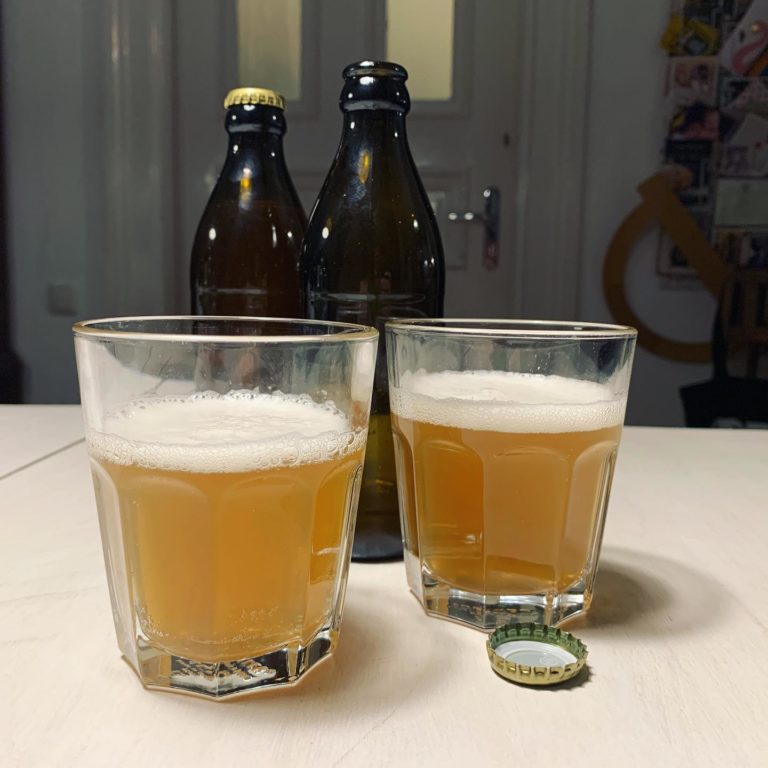Brewing your own beer is not difficult, but it is still not entirely effortless, and you actually need special equipment to make this fabulous ferment. Improvising with items from the household, as I do for many of my vegetable or alkaline ferments, I would not advise. I am listing here the cheapest alternatives of a brewing setup as I have in use myself. With this equipment for craft beer you can brew different types of beer yourself.
More is always possible, of course, and my husband, after years of brewing beer, now harbors an increased desire for a brewing kettle with electric agitator... At the beginning, however, it is really not necessary, who knows how intensively you will devote yourself to brewing beer in the future.

What equipment do you need to brew craft beer at home?
- Canning pot with temperature controller
- Fermentation bucket with outlet tap, lid and fermentation pipe
- large enough pots for 18 l of water
- Thermometer with probe
- lauter plate or lauter witch
- kitchen scale
- measuring cup / scoop
- large mixing spoon or mash paddle
- Ladle
- Cloth or fine sieve for filtering (e.g. boiled cheesecloth), better: hop filter
- Silicone tube
- Swing-top bottles of any size or bottles* & crown caps - then of course you need a
- Crown cap capping machine
- Wort spindle to measure the sugar content (optional)
- Dispensing tube (optional)
* I like to use recycled bottles and rarely buy new. It is important that they are as dark as possible, preferably brown. What type and what size is up to you. For top-fermented beer I personally like 0.5-liter bottles, my Gose I prefer to drink from 0.33-liter tubs and for special occasions I always fill beer into elegant 0.75-liter champagne bottles. That looks really classy on a beautifully set table.
With the basic equipment described, you can brew just about any type of beer. Simple and easy, but still delicious and popular with most beer drinkers is a top-fermented, cold-hopped Pale Ale. What a good thing that I've written down my favorite recipe for you, so you can start brewing right away!
Pale Ale «Schmidts 0815»
Which fermentation bucket is the best?
Of course, this is a matter of personal preference. In my opinion, the fermentation vessels from Speidel are extremely cute, they look like fellows from a long time ago in a galaxy far, far away - and of course they are practical as well. If I would have bought one myself, however, I don't know, because I was lucky and got my little one as a gift. I have bought the simplest version, a plain bucket with a lid, fermentation pipe and outlet. And the beer is great, so everything is fine.
Stainless steel fermenters are extremely chic, of course. Perhaps there will be an update in my home brewhouse at some point.
By the way, if you buy fermentation plus extra: I like the twisted fermentation pipes better than the cup-shaped ones. You can simply see better whether fermentation activity still takes place, so you can save one or the other measurement. I like it efficient 😉
What should you look for in a thermometer?
First of all, remember that the thermometer should measure and display the temperature during the entire mashing process. It is therefore logical that a thermometer with a waterproof temperature sensor is required. A really good solution is to have the sensor on a cable. The length of the cable should also not be too short, so that the display unit can be set up flexibly.
A water resistant device is also an advantage, as well as a digital indicator of the current temperature. My thermometer also has a visual and audible temperature alarm, so it can warn me if the mash gets too warm.
Of course, you can also use a wireless device and take the temperature manually every now and then. I suspect that this will soon become too annoying for you.
Equipment for craft beer: swing-top bottles or bottles with crown caps?
Das ist ein bisschen, wie mit den Fermentiergewichten aus Glas oder aus Ton, grundsätzlich nämlich unerheblich. Wie wir im Norden sagen: Wat dem een sin Uhl is dem annern sin Nachtigall.
For crown cap bottle: You can recycle used bottles from your household. Without a swing top, bottles are also easier to clean. The quality of the swing-top bottles also deteriorates over time, because the swing-tops lose their tension and the rubber seal can leak.
For swing-top bottle: You need one less device, the crown cap capping device, and of course don't generate trash with every bottle, the crown cork. And you don't have to think about the right crown cork size with swing top bottles either. And! you can use them for quite a few other great fermented drinks for which crown cork bottles would really be unsuitable because you can't burp them.





